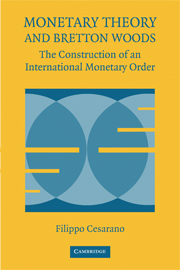Book contents
- Frontmatter
- Contents
- Preface
- Acknowledgments
- 1 INTRODUCTION
- 2 INTERNATIONAL MONETARY EQUILIBRIUM AND THE PROPERTIES OF THE GOLD STANDARD
- 3 THE INTERNATIONAL MONETARY SYSTEM BETWEEN THE WORLD WARS
- 4 THE MONETARY SYSTEM IN ECONOMIC ANALYSIS: THE CRITIQUE OF THE GOLD STANDARD
- 5 THE GREAT DEPRESSION: OVERTURNING THE STATE OF THE ART
- 6 PROVIDING FOR A NEW MONETARY ORDER
- 7 THE BRETTON WOODS AGREEMENTS
- 8 BRETTON WOODS AND AFTER
- References
- Author Index
- Subject Index
3 - THE INTERNATIONAL MONETARY SYSTEM BETWEEN THE WORLD WARS
Published online by Cambridge University Press: 18 December 2009
- Frontmatter
- Contents
- Preface
- Acknowledgments
- 1 INTRODUCTION
- 2 INTERNATIONAL MONETARY EQUILIBRIUM AND THE PROPERTIES OF THE GOLD STANDARD
- 3 THE INTERNATIONAL MONETARY SYSTEM BETWEEN THE WORLD WARS
- 4 THE MONETARY SYSTEM IN ECONOMIC ANALYSIS: THE CRITIQUE OF THE GOLD STANDARD
- 5 THE GREAT DEPRESSION: OVERTURNING THE STATE OF THE ART
- 6 PROVIDING FOR A NEW MONETARY ORDER
- 7 THE BRETTON WOODS AGREEMENTS
- 8 BRETTON WOODS AND AFTER
- References
- Author Index
- Subject Index
Summary
In the 1920s, international monetary developments were dominated by the interaction between the shocks of war and the aim of restoring the gold standard when the conditions for achieving that goal rapidly and without major welfare costs were lacking. Furthermore, the new cultural climate undermined the theoretical framework that had sustained a credible commodity standard. On the one hand, the advancement of monetary theory was uneven, offering conflicting solutions to the problems inherited from the war. On the other hand, policymakers remained attached to the gold standard, leading to take actions that actually aggravated the crisis. Indeed, the malfunctioning of the monetary system was a main factor in the onset of the depression and the worldwide transmission of its effects.
In reconstructing the monetary history of those years, it is common to subdivide the period according to the exchange rate regime in place (Redmond 1992, 346): an initial phase of floating rates that ended with Britain's return to the gold standard in April 1925; a short stage of fixed rates ending in September 1931, when sterling abandoned the gold standard; and a final phase of managed floating rates until the outbreak of World War II. A temporal division of monetary developments is even more significant from a different perspective, focusing not on the exchange rate regime, but on the rules and properties of the system.
- Type
- Chapter
- Information
- Monetary Theory and Bretton WoodsThe Construction of an International Monetary Order, pp. 42 - 67Publisher: Cambridge University PressPrint publication year: 2006

